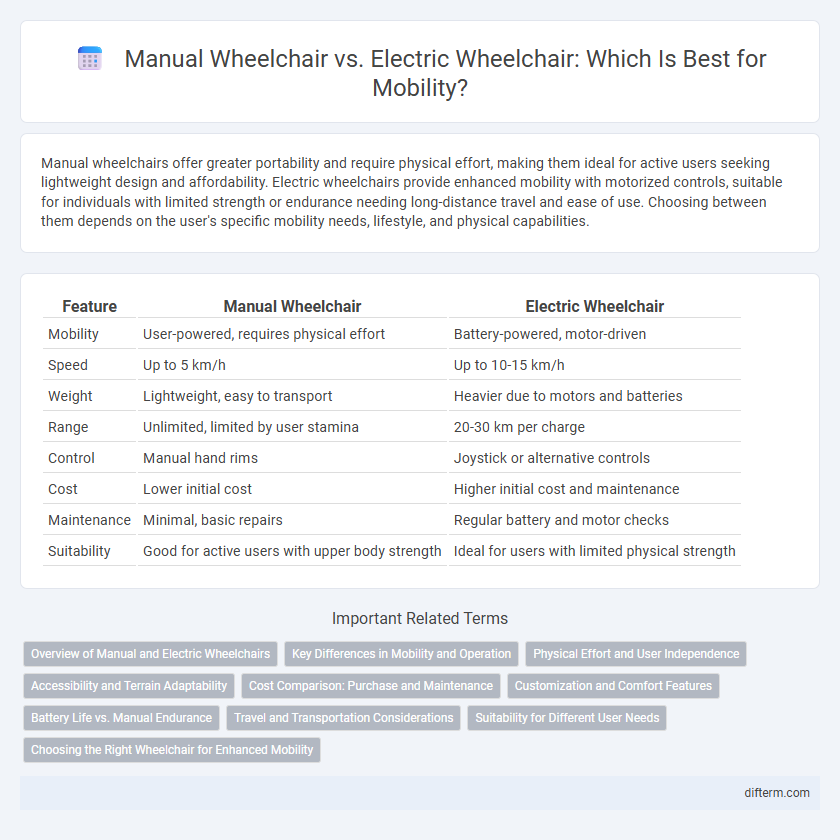Manual wheelchairs offer greater portability and require physical effort, making them ideal for active users seeking lightweight design and affordability. Electric wheelchairs provide enhanced mobility with motorized controls, suitable for individuals with limited strength or endurance needing long-distance travel and ease of use. Choosing between them depends on the user's specific mobility needs, lifestyle, and physical capabilities.
Table of Comparison
| Feature | Manual Wheelchair | Electric Wheelchair |
|---|---|---|
| Mobility | User-powered, requires physical effort | Battery-powered, motor-driven |
| Speed | Up to 5 km/h | Up to 10-15 km/h |
| Weight | Lightweight, easy to transport | Heavier due to motors and batteries |
| Range | Unlimited, limited by user stamina | 20-30 km per charge |
| Control | Manual hand rims | Joystick or alternative controls |
| Cost | Lower initial cost | Higher initial cost and maintenance |
| Maintenance | Minimal, basic repairs | Regular battery and motor checks |
| Suitability | Good for active users with upper body strength | Ideal for users with limited physical strength |
Overview of Manual and Electric Wheelchairs
Manual wheelchairs are typically lightweight, offer greater maneuverability, and require user physical strength for propulsion, making them ideal for short-distance mobility and active users. Electric wheelchairs provide powered assistance with various speed settings, enhanced comfort features, and are well-suited for individuals with limited upper body strength or longer travel needs. Both types vary in cost, maintenance requirements, and customization options, catering to diverse mobility challenges.
Key Differences in Mobility and Operation
Manual wheelchairs require physical effort from the user for propulsion and steering, making them suitable for short distances and individuals with upper body strength. Electric wheelchairs utilize battery-powered motors for movement, offering enhanced mobility and ease of operation, especially for users with limited strength or endurance. The choice between manual and electric wheelchairs depends on factors such as terrain, distance, user capability, and lifestyle needs.
Physical Effort and User Independence
Manual wheelchairs require significant upper body strength and endurance, making them suitable for users with adequate physical capability but limited for those with reduced stamina or mobility impairments. Electric wheelchairs minimize physical effort by using battery-powered motors, enhancing user independence for individuals with severe muscle weakness or mobility restrictions. This increased autonomy allows users to navigate longer distances and diverse terrains without fatigue, improving overall quality of life.
Accessibility and Terrain Adaptability
Manual wheelchairs offer greater accessibility in tight indoor spaces due to their lightweight design and compact size, making them ideal for maneuvering through narrow doorways and crowded environments. Electric wheelchairs excel in terrain adaptability with powerful motors and enhanced suspension systems, allowing users to navigate uneven surfaces, slopes, and outdoor terrains with ease. Choosing between manual and electric wheelchairs depends on the user's specific mobility needs, environment, and physical strength.
Cost Comparison: Purchase and Maintenance
Manual wheelchairs generally have a lower initial purchase price, typically ranging from $150 to $1,000, while electric wheelchairs can cost between $1,500 and $15,000 depending on features and brand. Maintenance costs for manual wheelchairs are minimal, mainly involving occasional tire replacements and cleaning, whereas electric wheelchairs require regular battery replacements, motor servicing, and electronic component repairs, increasing long-term expenses. Insurance coverage and accessibility of repair services also influence the overall cost-effectiveness of manual versus electric wheelchairs.
Customization and Comfort Features
Manual wheelchairs offer extensive customization options such as adjustable seat height, backrest angle, and lightweight frame materials, enhancing user-specific comfort and mobility. Electric wheelchairs provide advanced comfort features including powered recline, customizable joystick controls, and suspension systems designed for smooth rides over varied terrains. Both wheelchair types prioritize ergonomic seating and support cushions to reduce pressure sores and improve long-term comfort.
Battery Life vs. Manual Endurance
Electric wheelchairs offer battery lives ranging from 8 to 20 hours per charge, depending on usage and battery capacity, enabling longer travel distances without physical exertion. Manual wheelchairs require significant upper body strength and endurance, often leading to fatigue after extended use but providing unlimited range as long as the user can propel. Battery life in electric models limits continuous use, while manual endurance depends solely on the user's physical condition and stamina.
Travel and Transportation Considerations
Manual wheelchairs offer greater portability and ease of transport due to their lighter weight and compact design, making them ideal for frequent travelers and those relying on public transportation. Electric wheelchairs provide enhanced mobility over longer distances and uneven terrain but require larger vehicle adaptations and longer charging times, impacting travel convenience. Choosing between manual and electric wheelchairs depends on balancing travel frequency, transportation infrastructure, and user independence needs.
Suitability for Different User Needs
Manual wheelchairs offer greater control and physical exercise, making them suitable for users with sufficient upper body strength and active lifestyles. Electric wheelchairs provide enhanced mobility and independence for individuals with limited strength or endurance, supporting longer distances and varied terrains. Selecting the right wheelchair depends on factors such as user mobility level, daily activity requirements, and specific health conditions.
Choosing the Right Wheelchair for Enhanced Mobility
Manual wheelchairs offer lightweight design and greater maneuverability, making them ideal for active users who seek independence and physical exercise, while electric wheelchairs provide powered assistance suitable for users with limited upper body strength or those requiring longer travel distances. Factors such as user's physical capability, daily activity level, terrain, and battery life are essential in determining the most appropriate wheelchair type for enhanced mobility. Selecting the right wheelchair improves comfort, reduces fatigue, and promotes social participation by catering to individual mobility needs.
Manual wheelchair vs Electric wheelchair Infographic

 difterm.com
difterm.com